多个形容词修饰名词的顺序
- 格式:doc
- 大小:68.00 KB
- 文档页数:19
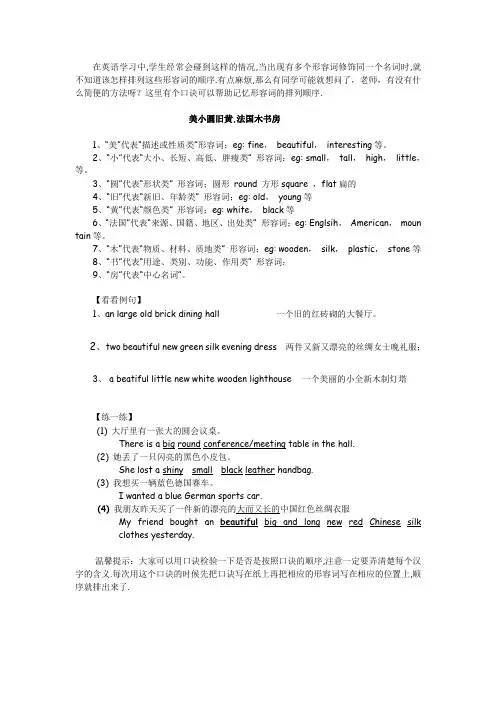
在英语学习中,学生经常会碰到这样的情况,当出现有多个形容词修饰同一个名词时,就不知道该怎样排列这些形容词的顺序.有点麻烦,那么有同学可能就想问了,老师,有没有什么简便的方法呀?这里有个口诀可以帮助记忆形容词的排列顺序.美小圆旧黄,法国木书房1、“美”代表“描述或性质类”形容词;eg: fine,beautiful,interesting等。
2、“小”代表“大小、长短、高低、胖瘦类” 形容词;eg: small,tall,high,little,等。
3、“圆”代表“形状类” 形容词;圆形round 方形square ,flat扁的4、“旧”代表“新旧、年龄类” 形容词;eg: old,young等5、“黄”代表“颜色类” 形容词;eg: white,black等6、“法国”代表“来源、国籍、地区、出处类” 形容词;eg: Englsih,American,moun tain等。
7、“木”代表“物质、材料、质地类” 形容词;eg: wooden,silk,plastic,stone等8、“书”代表“用途、类别、功能、作用类” 形容词;9、“房”代表“中心名词”。
【看看例句】1、an large old brick dining hall 一个旧的红砖砌的大餐厅。
2、two beautiful new green silk evening dress 两件又新又漂亮的丝绸女士晚礼服;3、 a beatiful little new white wooden lighthouse 一个美丽的小全新木制灯塔【练一练】(1) 大厅里有一张大的圆会议桌。
There is a big round conference/meeting table in the hall.(2) 她丢了一只闪亮的黑色小皮包。
She lost a shiny small black leather handbag.(3) 我想买一辆蓝色德国赛车。
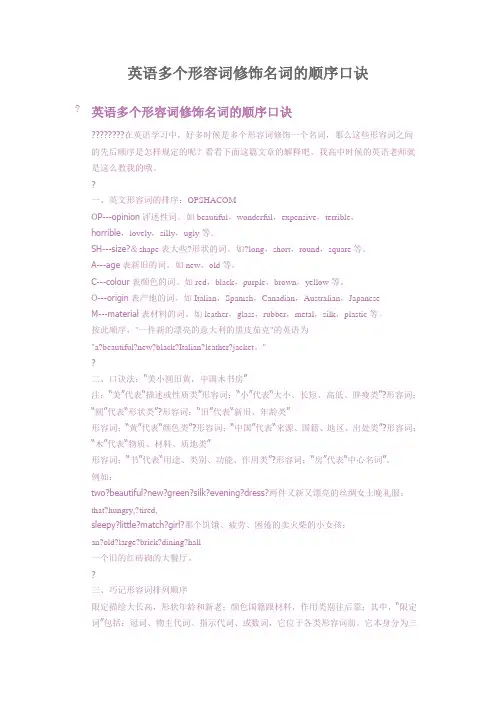
英语多个形容词修饰名词的顺序口诀? 英语多个形容词修饰名词的顺序口诀????????在英语学习中,好多时候是多个形容词修饰一个名词,那么这些形容词之间的先后顺序是怎样规定的呢?看看下面这篇文章的解释吧,我高中时候的英语老师就是这么教我的哦。
?一、英文形容词的排序:OPSHACOMOP---opinion评述性词。
如beautiful,wonderful,expensive,terrible,horrible,lovely,silly,ugly等。
SH---size?&shape表大些?形状的词。
如?long,short,round,square等。
A---age表新旧的词。
如new,old等。
C---colour表颜色的词。
如red,black,purple,brown,yellow等。
O---origin表产地的词。
如Italian,Spanish,Canadian,Australian,JapaneseM---material表材料的词。
如leather,glass,rubber,metal,silk,plastic等。
按此顺序,"一件新的漂亮的意大利的黑皮茄克"的英语为"a?beautiful?new?black?Italian?leather?jacket。
"?二、口诀法:“美小圆旧黄,中国木书房”注:“美”代表“描述或性质类”形容词;“小”代表“大小、长短、高低、胖瘦类”?形容词;“圆”代表“形状类”?形容词;“旧”代表“新旧、年龄类”形容词;“黄”代表“颜色类”?形容词;“中国”代表“来源、国籍、地区、出处类”?形容词;“木”代表“物质、材料、质地类”形容词;“书”代表“用途、类别、功能、作用类”?形容词;“房”代表“中心名词”。
例如:two?beautiful?new?green?silk?evening?dress?两件又新又漂亮的丝绸女士晚礼服;that?hungry,?tired,sleepy?little?match?girl?那个饥饿、疲劳、困倦的卖火柴的小女孩;an?old?large?brick?dining?hall一个旧的红砖砌的大餐厅。
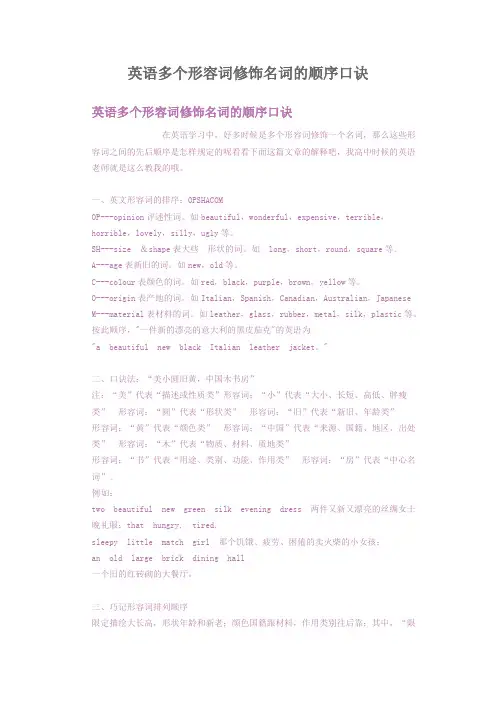
英语多个形容词修饰名词的顺序口诀英语多个形容词修饰名词的顺序口诀在英语学习中,好多时候是多个形容词修饰一个名词,那么这些形容词之间的先后顺序是怎样规定的呢看看下面这篇文章的解释吧,我高中时候的英语老师就是这么教我的哦。
一、英文形容词的排序:OPSHACOMOP---opinion评述性词。
如beautiful,wonderful,expensive,terrible,horrible,lovely,silly,ugly等。
SH---size &shape表大些形状的词。
如long,short,round,square等。
A---age表新旧的词。
如new,old等。
C---colour表颜色的词。
如red,black,purple,brown,yellow等。
O---origin表产地的词。
如Italian,Spanish,Canadian,Australian,JapaneseM---material表材料的词。
如leather,glass,rubber,metal,silk,plastic等。
按此顺序,"一件新的漂亮的意大利的黑皮茄克"的英语为"a beautiful new black Italian leather jacket。
"二、口诀法:“美小圆旧黄,中国木书房”注:“美”代表“描述或性质类”形容词;“小”代表“大小、长短、高低、胖瘦类”形容词;“圆”代表“形状类”形容词;“旧”代表“新旧、年龄类”形容词;“黄”代表“颜色类”形容词;“中国”代表“来源、国籍、地区、出处类”形容词;“木”代表“物质、材料、质地类”形容词;“书”代表“用途、类别、功能、作用类”形容词;“房”代表“中心名词”。
例如:two beautiful new green silk evening dress 两件又新又漂亮的丝绸女士晚礼服;that hungry, tired,sleepy little match girl 那个饥饿、疲劳、困倦的卖火柴的小女孩;an old large brick dining hall一个旧的红砖砌的大餐厅。
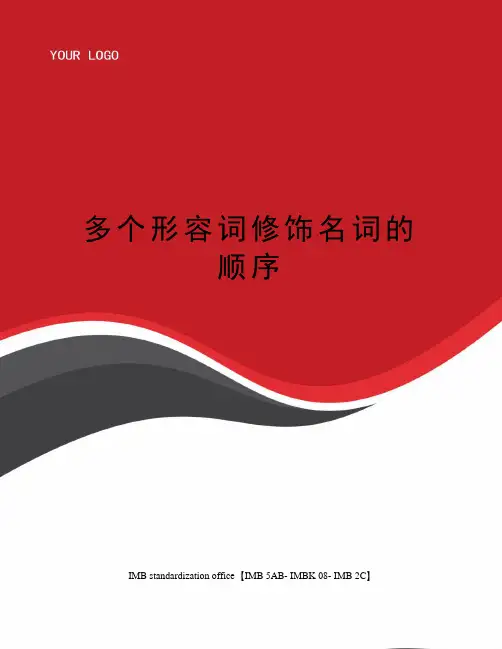
多个形容词修饰名词的顺序IMB standardization office【IMB 5AB- IMBK 08- IMB 2C】多个形容词修饰名词的顺序多个形容词修饰名词时,其顺序为:限定词--数词--描绘词--(大小,长短,形状,新旧,颜色)--出处--材料性质--类别--名词。
例如:asmallroundtable/atallgraybuilding/adirtyoldbrownshirt/afamousGermanmedicalscho ol/anexpensiveJapanesesportscar典型例题:1)Tonyisgoingcampingwith___boys.答案:C。
由"限定词--数词--描绘词--(大小,长短,形状,新旧,颜色)--性质--名词"的顺序可知数词,描绘词,性质依次顺序,只有C符合答案。
2)Onedaytheycrossedthe____bridgebehindthepalace.答案A.几个形容词修饰一个名词,他们的排列顺序是:年龄,形状,大小+颜色+来源+质地+用途+国家+名词。
3)----HowwasyourrecentvisittoQingdao?,andspentthe___daysattheseaside.(高考题)答案:B。
本题考查多个形容词的排序问题。
一般与被修饰形容词关系密切的形容词靠近名词;如果几个形容词的重要性差不多,音节少的形容词在前,音节多的方在后,在不能确定时,可参照:限定词+数量词(序数词在前,基数词在后)+性状形容词+大小、长短、高低等形体+新旧+颜色+国籍+材料+名词,如those+three+beautiful+large+square+old+brown+wood+table。
另给你送条顺口溜以便好记忆:县(限定词)官(观点形容词)行(形状形容词)大(大小形容词)令(年龄新旧形容词)射(颜色形容词)国(国家等出处形容词)才(材料质地等形容词)。
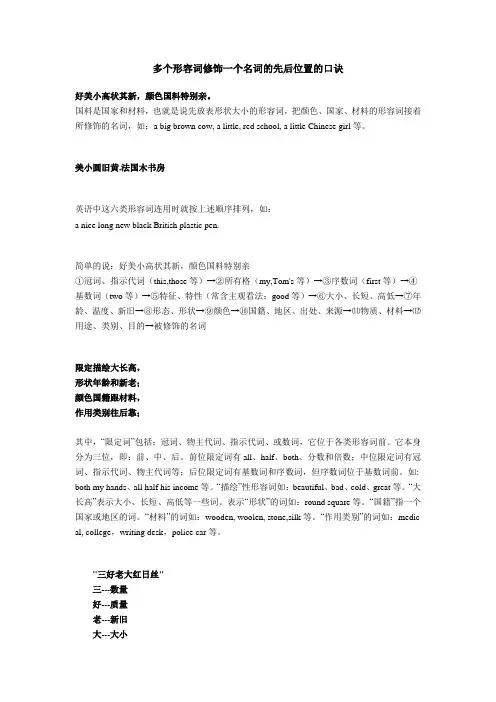
多个形容词修饰一个名词的先后位置的口诀好美小高状其新,颜色国料特别亲。
国料是国家和材料,也就是说先放表形状大小的形容词,把颜色、国家、材料的形容词接着所修饰的名词,如:a big brown cow, a little, red school, a little Chinese girl等。
美小圆旧黄,法国木书房英语中这六类形容词连用时就按上述顺序排列,如:a nice long new black British plastic pen.简单的说:好美小高状其新,颜色国料特别亲①冠词、指示代词(this,those等)→②所有格(my,Tom's等)→③序数词(first等)→④基数词(two等)→⑤特征、特性(常含主观看法;good等)→⑥大小、长短、高低→⑦年龄、温度、新旧→⑧形态、形状→⑨颜色→⑩国籍、地区、出处、来源→⑾物质、材料→⑿用途、类别、目的→被修饰的名词限定描绘大长高,形状年龄和新老;颜色国籍跟材料,作用类别往后靠;其中,“限定词”包括:冠词、物主代词、指示代词、或数词,它位于各类形容词前。
它本身分为三位,即:前、中、后。
前位限定词有all、half、both、分数和倍数;中位限定词有冠词、指示代词、物主代词等;后位限定词有基数词和序数词,但序数词位于基数词前。
如: both my hands、all half his income等。
“描绘”性形容词如:beautiful、bad、cold、great等。
“大长高”表示大小、长短、高低等一些词。
表示“形状”的词如:round square等。
“国籍”指一个国家或地区的词。
“材料”的词如:wooden, woolen, stone,silk等。
“作用类别”的词如:medic al, college,writing desk,police car等。
"三好老大红日丝"三---数量好---质量老---新旧大---大小红---颜色日---产地丝---质地高中英语修饰名词的一系列词的排列顺序如下:1冠词,数词2表性质特征的形容词3描写尺寸大小高矮的形容词4描写形状的形容词5描写新旧年龄的形容词6描写颜色的形容词7表示产地来源的形容词8表示制作材料的词9说明作用的词看了这么多的修饰词,谁能保证永远记住呢?我们还是借助口诀吧!请以说快板的方式把下面这一句话说出来”一个又脏又小,又圆又破,黑色的,吉普赛人的,羊毛做的,魔术用的帽子。

英语多个形容词修饰名词的顺序口诀集团文件发布号:(9816-UATWW-MWUB-WUNN-INNUL-DQQTY-英语多个形容词修饰名词的顺序口诀英语多个形容词修饰名词的顺序口诀????????在英语学习中,好多时候是多个形容词修饰一个名词,那么这些形容词之间的先后顺序是怎样规定的呢看看下面这篇文章的解释吧,我高中时候的英语老师就是这么教我的哦。
一、英文形容词的排序:OPSHACOMOP---opinion评述性词。
如beautiful,wonderful,expensive,terrible,horrible,lovely,silly,ugly等。
SH---size?&shape表大些?形状的词。
如?long,short,round,square等。
A---age表新旧的词。
如new,old等。
C---colour表颜色的词。
如red,black,purple,brown,yellow 等。
O---origin表产地的词。
如Italian,Spanish,Canadian,Australian,JapaneseM---material表材料的词。
如leather,glass,rubber,metal,silk,plastic等。
按此顺序,"一件新的漂亮的意大利的黑皮茄克"的英语为"a?beautiful?new?black?Italian?leather?jacket。
"二、口诀法:“美小圆旧黄,中国木书房”注:“美”代表“描述或性质类”形容词;“小”代表“大小、长短、高低、胖瘦类”?形容词;“圆”代表“形状类”?形容词;“旧”代表“新旧、年龄类”形容词;“黄”代表“颜色类”?形容词;“中国”代表“来源、国籍、地区、出处类”?形容词;“木”代表“物质、材料、质地类”形容词;“书”代表“用途、类别、功能、作用类”?形容词;“房”代表“中心名词”。
例如:two?beautiful?new?green?silk?evening?dress?两件又新又漂亮的丝绸女士晚礼服;that?hungry,?tired,sleepy?little?match?girl?那个饥饿、疲劳、困倦的卖火柴的小女孩;an?old?large?brick?dining?hall一个旧的红砖砌的大餐厅。
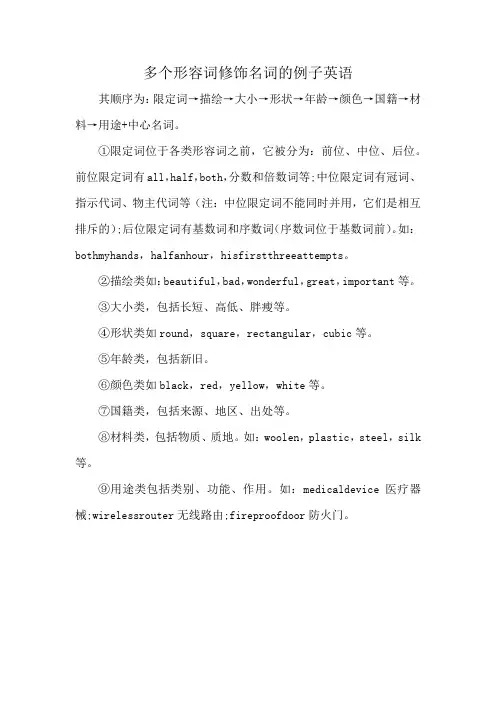
多个形容词修饰名词的例子英语
其顺序为:限定词→描绘→大小→形状→年龄→颜色→国籍→材料→用途+中心名词。
①限定词位于各类形容词之前,它被分为:前位、中位、后位。
前位限定词有all,half,both,分数和倍数词等;中位限定词有冠词、指示代词、物主代词等(注:中位限定词不能同时并用,它们是相互排斥的);后位限定词有基数词和序数词(序数词位于基数词前)。
如:bothmyhands,halfanhour,hisfirstthreeattempts。
②描绘类如:beautiful,bad,wonderful,great,important等。
③大小类,包括长短、高低、胖瘦等。
④形状类如round,square,rectangular,cubic等。
⑤年龄类,包括新旧。
⑥颜色类如black,red,yellow,white等。
⑦国籍类,包括来源、地区、出处等。
⑧材料类,包括物质、质地。
如:woolen,plastic,steel,silk 等。
⑨用途类包括类别、功能、作用。
如:medicaldevice医疗器械;wirelessrouter无线路由;fireproofdoor防火门。
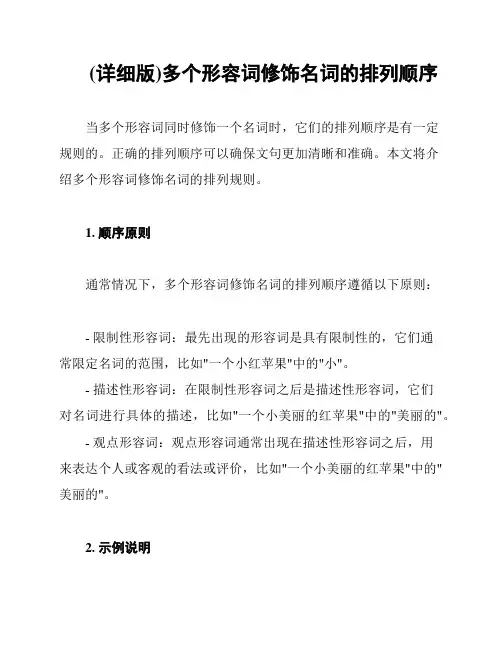
(详细版)多个形容词修饰名词的排列顺序当多个形容词同时修饰一个名词时,它们的排列顺序是有一定规则的。
正确的排列顺序可以确保文句更加清晰和准确。
本文将介绍多个形容词修饰名词的排列规则。
1. 顺序原则通常情况下,多个形容词修饰名词的排列顺序遵循以下原则:- 限制性形容词:最先出现的形容词是具有限制性的,它们通常限定名词的范围,比如"一个小红苹果"中的"小"。
- 描述性形容词:在限制性形容词之后是描述性形容词,它们对名词进行具体的描述,比如"一个小美丽的红苹果"中的"美丽的"。
- 观点形容词:观点形容词通常出现在描述性形容词之后,用来表达个人或客观的看法或评价,比如"一个小美丽的红苹果"中的"美丽的"。
2. 示例说明以下是一些示例,展示了多个形容词修饰名词的排列顺序:- 一个年轻的漂亮女孩。
- 一辆新的红色跑车。
- 一幅古老的名画。
- 一首深情的浪漫情歌。
3. 注意事项虽然上述原则通常适用,但有时候也会有例外情况。
在特定的语境中,可能需要根据表达的需要灵活调整形容词的顺序。
此外,还需要注意以下几点:- 形容词修饰名词时,应注意一致性:形容词在性、数、格上要与名词保持一致。
- 当形容词之间有连词时,通常不会改变它们的原始顺序,比如"一个年轻而漂亮的女孩"。
- 在一些特殊用法中,形容词也可以放在名词之后,但这种情况相对较少。
4. 总结在多个形容词修饰名词的情况下,正确的顺序可以提高表达的准确性和清晰度。
通常情况下,限制性形容词先于描述性形容词,而观点形容词通常位于最后。
但在具体语境中,需要根据需要进行灵活调整。
了解这些规则和注意事项可以帮助我们更好地运用形容词修饰名词。
5. 参考文献。
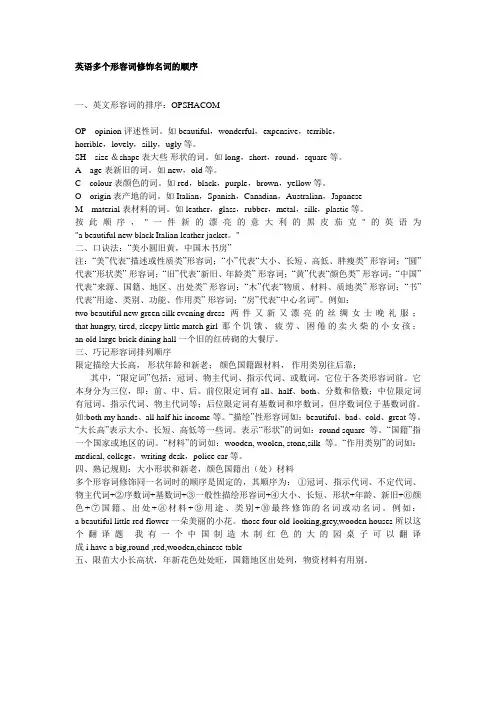
英语多个形容词修饰名词的顺序一、英文形容词的排序:OPSHACOMOP---opinion评述性词。
如beautiful,wonderful,expensive,terrible,horrible,lovely,silly,ugly等。
SH---size &shape表大些形状的词。
如 long,short,round,square等。
A---age表新旧的词。
如new,old等。
C---colour表颜色的词。
如red,black,purple,brown,yellow等。
O---origin表产地的词。
如Italian,Spanish,Canadian,Australian,JapaneseM---material表材料的词。
如leather,glass,rubber,metal,silk,plastic等。
按此顺序,"一件新的漂亮的意大利的黑皮茄克"的英语为"a beautiful new black Italian leather jacket。
"二、口诀法:“美小圆旧黄,中国木书房”注:“美”代表“描述或性质类”形容词;“小”代表“大小、长短、高低、胖瘦类”形容词;“圆”代表“形状类”形容词;“旧”代表“新旧、年龄类”形容词;“黄”代表“颜色类”形容词;“中国”代表“来源、国籍、地区、出处类”形容词;“木”代表“物质、材料、质地类”形容词;“书”代表“用途、类别、功能、作用类”形容词;“房”代表“中心名词”。
例如:two beautiful new green silk evening dress 两件又新又漂亮的丝绸女士晚礼服;that hungry, tired, sleepy little match girl 那个饥饿、疲劳、困倦的卖火柴的小女孩;an old large brick dining hall 一个旧的红砖砌的大餐厅。
三、巧记形容词排列顺序限定描绘大长高,形状年龄和新老;颜色国籍跟材料,作用类别往后靠;其中,“限定词”包括:冠词、物主代词、指示代词、或数词,它位于各类形容词前。
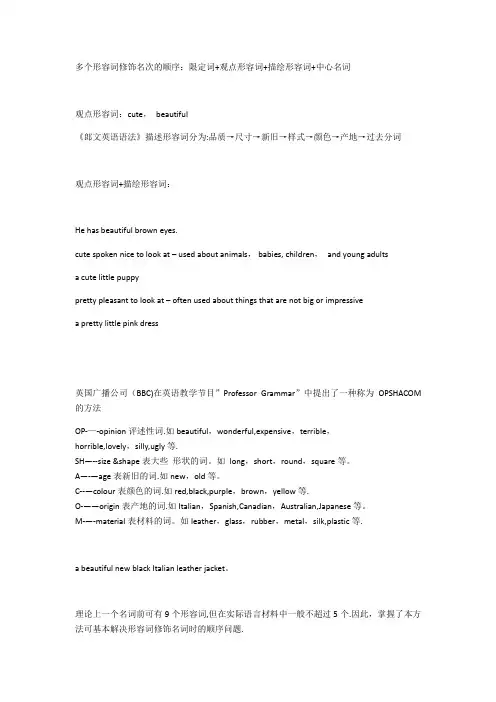
多个形容词修饰名次的顺序:限定词+观点形容词+描绘形容词+中心名词观点形容词:cute,beautiful《郎文英语语法》描述形容词分为:品质→尺寸→新旧→样式→颜色→产地→过去分词观点形容词+描绘形容词:He has beautiful brown eyes.cute spoken nice to look at – used about animals, babies, children,and young adultsa cute little puppypretty pleasant to look at – often used about things that are not big or impressivea pretty little pink dress英国广播公司(BBC)在英语教学节目”Professor Grammar”中提出了一种称为OPSHACOM 的方法OP-—-opinion评述性词.如beautiful,wonderful,expensive,terrible,horrible,lovely,silly,ugly等.SH—--size &shape表大些形状的词。
如long,short,round,square等。
A—-—age表新旧的词.如new,old等。
C--—colour表颜色的词.如red,black,purple,brown,yellow等.O-——origin表产地的词.如Italian,Spanish,Canadian,Australian,Japanese 等。
M-—-material表材料的词。
如leather,glass,rubber,metal,silk,plastic等.a beautiful new black Italian leather jacket。
理论上一个名词前可有9个形容词,但在实际语言材料中一般不超过5个.因此,掌握了本方法可基本解决形容词修饰名词时的顺序问题.学习OPSHACOM方法时还要注意以下事项:1 各修饰词(即形容词)可有缺项,但顺序不变。
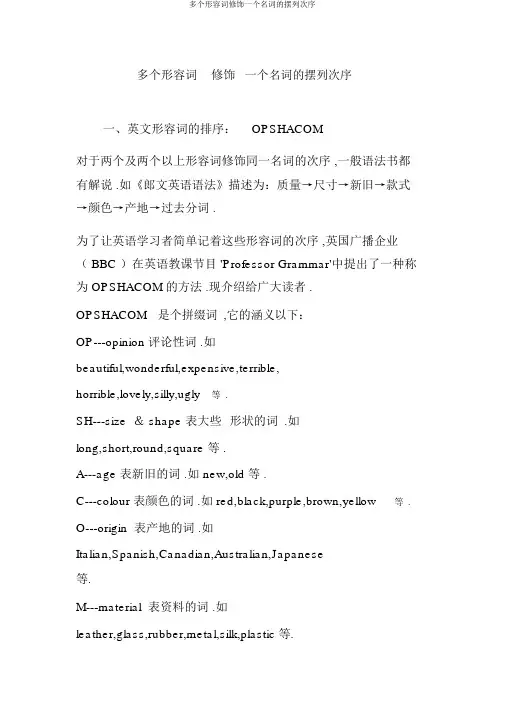
多个形容词修饰一个名词的摆列次序一、英文形容词的排序:OPSHACOM对于两个及两个以上形容词修饰同一名词的次序 ,一般语法书都有解说 .如《郎文英语语法》描述为:质量→尺寸→新旧→款式→颜色→产地→过去分词 .为了让英语学习者简单记着这些形容词的次序 ,英国广播企业( BBC )在英语教课节目 'Professor Grammar'中提出了一种称为 OPSHACOM 的方法 .现介绍给广大读者 .OPSHACOM是个拼缀词,它的涵义以下:OP---opinion 评论性词 .如beautiful,wonderful,expensive,terrible,horrible,lovely,silly,ugly等.SH---size & shape 表大些形状的词.如long,short,round,square 等 .A---age 表新旧的词 .如 new,old 等 .C---colour 表颜色的词 .如 red,black,purple,brown,yellow等. O---origin 表产地的词 .如Italian,Spanish,Canadian,Australian,Japanese等.M---material 表资料的词 .如leather,glass,rubber,metal,silk,plastic 等.按此次序 ,'一件新的漂亮的意大利的黑皮茄克'的英语为 'a beautiful new black Italian leather jacket.'理论上一个名词前可有9 个形容词 ,但在实质语言资猜中一般不超出 5 个 .所以 ,掌握了本方法可基本解决形容词修饰名词时的次序问题.学习 OPSHACOM 方法时还要注意以下事项:1 各修饰词(即形容词)可出缺项,但次序不变 .如: a small Swiss watch.2 当表大小(或长短)的词与表形状的词同时出现时,大小(或长短)在前 ,形状在后 .如: a large square table.3定冠词、不定冠词、指示代词、形容词性全部格、数词等位于句首 .4数词位于定冠词、指示代词后 .(数词不与不定冠词或形容词性全部格连用)5分词最凑近所修饰的名词 .如: his new Japanese timing device; three scottish handmade skirts.下边请读者做几道练习题:用 OPSHACOM 法将以下各题括号中的单词按正确次序摆列:1.( Canadian ,extraordinary ,an ,new ) play2.( green,a,large) garden3.( gold,British,the,round ) coin4.( ugly,writing,the,steel,seven ) desks5.( purple ,Russian ,nice ,long ,her )coat答案:1. an extraordinary new Canadian play2. a large green garden3. the round British gold coin4. the seven ugly steel writing desks5. her nice long purple Russian coat二、口诀法:“美小圆旧黄 ,中国木书斋”在外语学习中,记忆是一个特别重要的环节 .和外语对比,学生一般对自己母语更敏感,记忆母语更简单,印象更深刻 .当学生在记忆外语词汇或语言知识时 ,总喜爱将其与母语挂钩 .教师应联合详细状况利用母语帮助学生理解记忆 .比如学生对名词前的修饰语的次序弄不清 ,考试中常常犯错 .利用下边代替字构成的句子帮助记忆 ,教课成效就比较好 . “美小圆旧黄 ,中国木书斋” .注:“美”代表“描述或性质类”形容词;“小”代表“大小、长短、高低、胖瘦类” 形容词;“圆”代表“形状类” 形容词;“旧”代表“新旧、年纪类” 形容词;“黄”代表“颜色类” 形容词;“中国”代表“根源、国籍、地域、出处类”形容词;“木”代表“物质、资料、质地类” 形容词;“书”代表“用途、类型、功能、作用类” 形容词;“房” 代表“中心名词”.比如:two beautiful new green silk evening dress两件又新又漂亮的丝绸女士晚制服;that hungry, tired, sleepy little match girl那个饥饿、疲惫、困倦的卖火柴的小女孩;an old large brick dining hall一个旧的红砖砌的大餐厅.三、巧记形容词摆列次序请看下边一道高考题:This____girl Linda's conusin.(2005北京卷)A. pretty little SpanishB. Spanish little prettyC. Spanish prettyD. liite pretty Spanish本题选 A. 该题时对形容词摆列次序的观察.在英语中 ,当名词有多个形容词修饰时 ,就有它们的先后次序.下边的口诀可帮你记着这一先后次序 ,也是解题的重点 .限制描述大长高,形状年纪和新老;颜色国籍跟资料,作用类型今后靠;此中 ,“限制词”包含:冠词、物主代词、指示代词、或数词,它位于各种形容词前 .它自己分为三位 ,即:前、中、后 .前位限制词有 all 、 half 、both、分数和倍数;中位限制词有冠词、指示代词、物主代词等;后位限制词有基数词和序数词,但序数词位于基数词前.如 :both my hands 、 all half his income等.“描述”性形容词如:beautiful 、bad、cold、great 等 .“大长高” 表示大小、长短、高低等一些词 .表示“形状” 的词如:round square 等 .“国籍”指一个国家或地域的词 .“资料”的词如: wooden, woolen, stone,silk 等 .“作用类型”的词如:medical, college,writing desk,police car等.另一口诀 :县官行令杀国材 .县,表示限制词;官,指的是冠词;行,表示性质的定语;令,表示年纪;杀,表示颜色;国,表示国籍;材,表示资料 .你有兴趣的话 ,不如也试一试编个'顺口溜 '玩玩 .四、熟记规则:大小形状和新老,颜色国际出(处)资料多个形容词修饰同一名词时的次序是固定的,其次序为:①冠词、指示代词、不定代词、物主代词+②序数词 +基数词 +③一般性描述形容词+④大小、长短、形状+年纪、新旧+⑥颜色 +⑦国籍、出处 +⑧资料 +⑨用途、类型 +⑩最后修饰的名词或动名词 .比如: a beautiful little red flower 一朵漂亮的小花. those four old-looking,grey,wooden houses 所以这个翻译题我有一此中国制造木制红色的大的园桌子能够翻译成i have a big,round ,red,wooden,chinese table形容词的序次有一个口诀.能够记下来:大小形状和新老,颜色国际出(处)资料请依据形容词摆列规则达成以下练习:has a ___ jacket.(leather,brown,beautiful)has a ___ car. (american,long,red)live in a ___ house. (old,beautiful)have a ___ table. (antique,small,wooden)has a ___ jumper. (woollen, lovely, red)has a ___ ring. (diamond,new,fabulous)was a ___ song.(french,old, lovely)owns a ___ dog.(black,horrible,big)bought a ___ scarf.(gorgeous,silk,pink)saw a ___ film. (new,fantastic, british)答案: brown leather jacket. red american car. old house. antique wooden table. red woollen jumper. new diamond ring. old french song. big black dog. pink silk scarf. new british film.。
多个形容词修饰名词的顺序集团文件版本号:(M928-T898-M248-WU2669-I2896-DQ586-M1988)多个形容词修饰名词的顺序多个形容词修饰名词时,其顺序为:限定词--数词--描绘词--(大小,长短,形状,新旧,颜色)--出处--材料性质--类别--名词。
例如:a small round table/ a tall gray building/ a dirty old brown shirt/ a famous German medical school/ an expensive Japanese sports car典型例题:1) Tony is going camping with ___ boys.A. little two otherB. two little otherC. two other littleD. little other two答案:C。
由"限定词--数词--描绘词--(大小,长短,形状,新旧,颜色) --性质--名词"的顺序可知数词,描绘词,性质依次顺序,只有C 符合答案。
2) One day they crossed the ____bridge behind the palace.A. old Chinese stoneB. Chinese old stoneC. old stone ChineseD. Chinese stone old答案A. 几个形容词修饰一个名词,他们的排列顺序是:年龄,形状,大小+颜色+来源+质地+用途+国家+名词。
3) ---- How was your recent visit to Qingdao?---- It was great. We visited some friends,and spent the___days at the seaside.(高考题)A. few last sunnyB. last few sunnyC. last sunny fewD. few sunny last答案:B。
巧记英语多个形容词修饰名词的顺序导语:在英语学习中,好多时候是多个形容词修饰一个名词,那么这些形容词之间的先后顺序是怎样规定的呢?看看下面这篇文章的解释吧。
一、英文形容词的排序:OPSHACOMOP---opinion评述性词。
如beautiful,wonderful,expensive,terrible,horrible,lovely,silly,ugly等。
SH---size &shape表大小、形状的词。
如long,short,round,square 等。
A---age表新旧的词。
如new,old等。
C---colour表颜色的词。
如red,black,purple,brown,yellow等。
O---origin表产地的词。
如Italian,Spanish,Canadian,Australian,JapaneseM---material表材料的词。
如leather,glass,rubber,metal,silk,plastic 等。
按此顺序,"一件新的漂亮的意大利的黑皮茄克"的英语为"a beautiful new black Italian leather jacket。
"二、口诀法:“美小圆旧黄,中国木书房”注:“美”代表“描述或性质类”形容词;“小”代表“大小、长短、高低、胖瘦类”形容词;“圆”代表“形状类”形容词;“旧”代表“新旧、年龄类”形容词;“黄”代表“颜色类”形容词;“中国”代表“来源、国籍、地区、出处类”形容词;“木”代表“物质、材料、质地类”形容词;“书”代表“用途、类别、功能、作用类”形容词;“房”代表“中心名词”。
例如:two beautiful new green silk evening dress 两件又新又漂亮的丝绸女士晚礼服;that hungry, tired, sleepy little match girl 那个饥饿、疲劳、困倦的卖火柴的小女孩;an old large brick dining hall 一个旧的红砖砌的大餐厅。
多个形容词修饰名词的顺序多个形容词修饰名词时,其顺序为:限定词--数词--描绘词--(大小,长短,形状,新旧,颜色) --出处--材料性质,类别--名词a small round tablea tall gray buildinga dirty old brown shirta famous German medical schoolan expensive Japanese sports car典型例题:1) Tony is going camping with ___ boys.A. little two otherB. two little otherC. two other littleD. little other two答案:C。
由"限定词--数词--描绘词--(大小,长短,形状,新旧,颜色) --性质--名词"的公式可知数词,描绘词,性质依次顺序,只有C符合答案。
2) One day they crossed the ____bridge behind the palace.A. old Chinese stoneB. Chinese old stoneC. old stone ChineseD. Chinese stone old答案A. 几个形容词修饰一个名词,他们的排列顺序是:年龄,形状,大小+颜色+来源+质地+用途+国家+名词。
3) ---- How was your recent visit to Qingdao---- It was great. We visited some friends,and spent the ___days at the seaside.A. few last sunnyB. last few sunnyC. last sunny fewD. few sunny last 答案:B。
本题考查多个形容词的排序问题。
一般与被修饰形容词关系密切的形容词靠近名词;如果几个形容词的重要性差不多,音节少的形容词在前,音节多的方在后,在不能确定时,可参照下表:限定词+数量词(序数词在前,基数词在后)+性状形容词+大小、长短、高低等形体+ those + three + beautiful + large + square新旧+颜色+国籍+材料+名词old + brown + wood + table定义:副词是一种用来修饰动词,形容词,副词或全句的词,说明时间,地点,程度,方式等概念。
分类:1) 时间和频度副词:now,then,often,always,usually,early,today, lately, next,last,already,generally,frequently, seldom,ever,never,yet,soon,too, immediately, hardly,finally,shortly, before, ago,sometimes, yesterday.2) 地点副词:here, there, everywhere, anywhere, in, out, inside, outside, above, below, down, back, forward, home, upstairs, downstairs, across, along, round , around, near, off, past, up, away, on. 3) 方式副词:carefully, properly, anxiously, suddenly, normally, fast, well, calmly, politely, proudly, softly, warmly4) 程度副词:much,little, very,rather,so,too,still, quite, perfectly, enough, extremely, entirely,almost, slightly.5) 疑问副词:how, when, where, why.6) 关系副词:when, where, why.7) 连接副词:how, when, where, why, whether.用法:副词在句中可作状语,表语,短语。
He works hard.他工作努力。
You speak English quite well.你英语讲的很好。
Is she in她在家吗Let's be out.让我们出去吧。
Food here is hard to get.这儿很难弄到食物。
位置:1) 多数副词都可以放在动词的后面,如果动词带有宾语,副词就放在宾语后面。
I get up early in the morning everyday.我每天早早起床。
He gave me a gift yesterday.他昨天给了我一件礼物。
She didn't drink water enough.她没喝够水。
The train goes fast.火车跑得快。
We can go to this school freely.我们可以免费到这家学校学习。
They left a life hardly then.当时他们的生活很艰难。
He has a new cat on today.他今天戴了一顶新帽子。
I have seen this film twice with my friends.这部电影我和朋友看过两次。
2) 副词修饰形容词,副词时,副词在前面,而被修饰的词在后面。
It's rather easy, I can do it.这很容易,我能做到。
He did it quite well.他做得相当好。
It's rather difficult to tell who is right.很难说谁是对的。
It's so important that I must tell my friends.这件事太重要了,我得告诉我的朋友。
It's much better.好多了。
3) 频度副词可放在实义动词的前面,情态动词和助动词的后面。
I often help him these days.这些日子我经常帮助他。
I always remember the day when I first cameto this school.我常常记得我第一次来学校的那一天。
You mustn't always help me.你不能老是帮助我。
He seldom comes to see us.他很少来看我们。
We usually go shopping once a week.我们通常一周买一次东西。
The new students don't always go to dance.新学生并不时常去跳舞。
4) 疑问副词,连接副词,关系副词以及修饰整个句子的副词,通常放在句子或从句的前面。
When do you study everyday你每天什么时间学习Can you tell me how you did it你能告诉我你如何做的吗First, let me ask you some questions.先让我来问几个问题。
How much does this bike cost这辆车子多少钱Either you go or he comes.不是你去就是他来。
The students were reading when the teacher came into the classroom.当老师进教室时,学生们正在读书。
5) 时间副词和地点副词在一个句中, 地点副词在前面时间副词在后面。
We went shopping in the supermarket at 9 o'clock yesterday.昨天九点钟我们到超市买东西了.What were you doing in the classroom yesterday evening昨天下午你在教室里干什么The accident took place one hour ago in the Eleven Avenue.一小时前十一号大街发生了一场事故。
比较等级:副词和形容词一样,也有它的比较级和最高级形式. 可以参考形容词的变换形式。
但以词尾 -ly 结尾的副词(除 early )须用 more 和 most 。
hard harder hardestfast faster fastestearly earlier earliestmuch more mostwarmly more warmly most warmly单音节副词的比较级是在副词后面加上 -er 构成的,最高级是在副词后面加上 -est 构成的。
near nearer nearesthard harder hardest多音节副词的比较级是在副词的前面加上 -more 构成的。
最高级是在副词前面加上 -most 构成的。
warmly more warmly most warmlysuccessfully more successfully most successfully有些副词的比较级和最高级形式是不规则的。
well-better - best little - less - leastMuch- more - most badly - worse - worstfar-farther(further)-farthest(furthest)副词的比较级和最高级用法同形容词的比较级用法基本一样。
最高级形式句中 the 可以省略。
He works harder than I.他比我工作努力。
Lucy gets up earlier than Lili.露西比丽丽起床早。
He runs fastest in our class.他在我们班跑地最快。
He dives deeper than his teammates.他比他的队员潜水深。
It's true that he speak English more fluently than any of us.他英语讲的确实比我们任何人都好。
Our school team play football best in our region.我们校队在我们地区足球踢得最好的。
副词比较级和最高级的形式副词比较级和最高级的变化形式与形容词基本上一样一般副词hard→harder →hardestfast→faster →fastestlate→later →latestearly→earlier →earliest特殊副词well →better →bestmuch →more →mostbadly →worse →worstlittle →less →least 但是,开放类副词即以后缀ly结尾的副词不能像形容词那样加er或est,如quick ly →more quickly →most quickly quietly →more quietly →most quietly〔注〕: early中的ly不是后缀,故可以把y变i再加er和est比较级和最高级的基本用法一、原级比较的基本用法1. 原级比较由“as+形容词或副词(或再加名词或短语)+as ”构成“原级相同”比较句,表示两者比较;其否定式,即“程度不及”比较句型为“not so(as) +形容词或副词+as”,而且as…as结构前可用just, almost, nearly, quite等表示程度的词修饰1) Walking briskly for thirty minutes will burn as many calories as .〔A〕 to run for fifteen minutes〔B〕 running for fifteen minutes〔C〕 you run for fifteen minutes〔D〕 fifteen minute walking2) The gorilla(大猩猩), while 〔A〕 not quite as curious than 〔B〕 the chimpanzee(黑猩猩),shows more persistence 〔C〕 and memory retention(记忆力) in solving 〔D〕 a problem.3) Alaska is twice 〔A〕 as larger 〔B〕 as 〔C〕 the next largest 〔D〕 state, Texas.2. “as (so)+名词+as+名词”进行名词比较,这时一般情况下有一个表示原级的比较词,但如果第一名词前出现了形容词修饰该词或出现副词修饰谓语,应当用so而不用as4) Thomas Jefferson’s achievements as an architect rival his contributions a politician. 〔A〕 such〔B〕 more〔C〕 as〔D〕 than5) I should say Henry is not much a writer as a reporter. (88年考题)〔A〕 that〔B〕 so〔C〕 this〔D〕 as二、比较级1. 比较级由“形容词(副词)比较级+than+…,”构成表示在两者中间一方比另一方“更加…”。